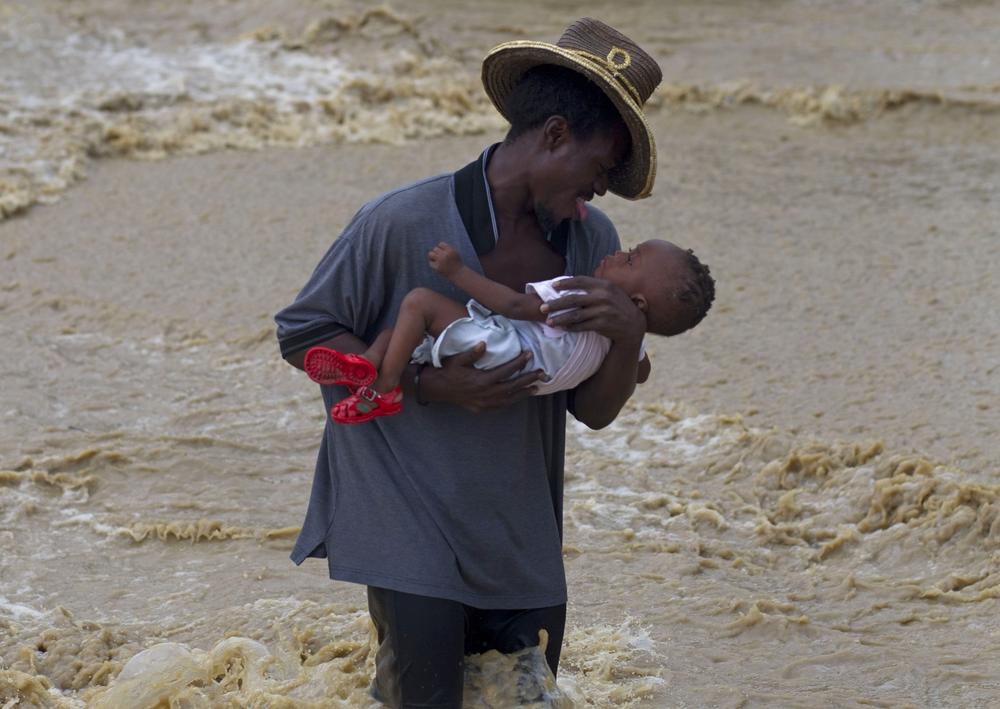Advertisement
Tomas Loses Hurricane Status After Soaking Haiti

Tropical Storm Tomas spun away from the Turks and Caicos Islands and into the open Atlantic on Saturday, gradually losing steam a day after battering seaside towns in Haiti as a hurricane.
A tropical storm warning for Haiti was discontinued but a massive gray wall of clouds threatened to bring up to 2 more inches (5 centimeters) of rain over parts of the country, according to the U.S. National Hurricane Center in Miami. Warnings were still in effect for the Turks and Caicos, the southeastern Bahamas, and the northern coast of the Dominican Republic.
On Saturday morning, the storm's center was about 70 miles (110 kilometers) north of Grand Turk Island, which lost power overnight when utility lines toppled. It had maximum sustained winds of 70 mph (110 kph), the center reported.
Emergency officials in the Turks and Caicos said there were no immediate reports of significant damage, and islanders breathed a sigh of relief.
"I believed it would have been harder," said 25-year-old Andrea Been, hunched under an umbrella in Providenciales. "I though we would have had more rains and winds."
As a Category 1 hurricane on Friday, Tomas spared most earthquake-refugee camps in the capital but hit a seaside town that was nearly destroyed by January's earthquake.
Coming ashore at Haiti's far southwestern edge, Tomas slammed the coastline with 85-mph (135-kph) winds, damaged buildings with gale-force winds and flooded several towns including Leogane, which lost 90 percent of its buildings and thousands of people in the Jan. 12 quake.
Civil protection authorities said Saturday that at least six people were killed in the storm, with two people missing.
Reports have only begun to filter in from isolated mountain towns cut off by flooding. But as officials took stock and aid workers rushed to contain flood damage and a widening cholera epidemic, Tomas left harsh reminders of poverty's toll on the Caribbean nation.
"We have two catastrophes that we are managing. The first is the hurricane and the second is cholera," President Rene Preval said Friday in a television and radio address.
He could have included a third: the scores of collapsed buildings and sprawling refugee camps that still dominate the landscape 10 months after a magnitude-7 earthquake turned the capital into rubble. In the capital, Port-au-Prince, Tomas turned streets into canals of flowing garbage, but
Old and new disasters mingled in Leogane, where milky brown floodwaters filled quake-cracked streets and cut off a camp that had been home to hundreds of refugees.
Dozens of families carried their belongings through thigh-high floodwaters to a taxi stand on higher ground, huddling under blankets and a sign that read "Welcome to Leogane."
"We got flooded out and we're just waiting for the storm to pass. There's nothing we can do," said Johnny Joseph, a 20-year-old resident.
Protesters in Leogane took to the streets in the pouring rain, beating drums and blasting horns as they lambasted officials for failing to build a canal along a river that has overflowed repeatedly in the past. Floodwaters filled people's homes, swirling around the furniture and framed pictures.
"When it rains the water rises and causes so much damage. We want them to dig a canal to move the water," said Frantz Hilair, a 28-year-old motorcycle-taxi driver. "We have a mayor and the deputy, but they don't do anything."
Local authorities blamed the federal government.
Haitian authorities had urged the 1.3 million people left homeless by the earthquake in Port-au-Prince to leave the camps and go to the homes of friends and family. Buses were sent to take those who wanted to evacuate to shelters.
But many chose to stay under the camps' donated plastic tarps out of fear that they could be evicted from the private land where they have been camped out since the quake. They also feared losing their few possessions.
A near-riot broke out amid a poorly coordinated relocation effort at the government's flagship camp, Corail-Cesselesse, when residents began overturning tables and throwing bottles to protest what they saw as a forced removal.
About a third of the camp's nearly 8,000 residents ultimately went to shelters in a nearby school, church and hospital, American Refugee Committee camp manager Bryant Castro said.
Poverty has steadily worsened in Haiti over the past century, with an unending spiral of political upheaval, flawed international intervention, frustrated aid attempts and natural disasters. Post-quake reconstruction has barely begun or even been funded; less than 38 percent of the money pledged for rebuilding has been delivered, including a promised $1.15 billion from the United States.
Aid workers are concerned the storm will worsen Haiti's cholera epidemic, which has killed more than 440 people and hospitalized more than 6,700 others.
Tomas killed at least 14 people earlier in the eastern Caribbean.
This program aired on November 6, 2010. The audio for this program is not available.